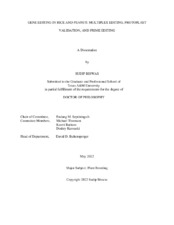| dc.contributor.advisor | Septiningsih, Endang | |
| dc.creator | Biswas, Sudip | |
| dc.date.accessioned | 2023-02-07T16:18:20Z | |
| dc.date.available | 2024-05-01T06:06:11Z | |
| dc.date.created | 2022-05 | |
| dc.date.issued | 2022-04-19 | |
| dc.date.submitted | May 2022 | |
| dc.identifier.uri | https://hdl.handle.net/1969.1/197324 | |
| dc.description.abstract | CRISPR-Cas9 is a powerful and versatile genome-editing tool for introducing genetic changes for studying gene expression and improving crops, including rice (Oryza sativa L.) and peanut (Arachis hypogaea L.). Resistant starch is a starch product that is not easily digestible and absorbed in the stomach or small intestine and instead is passed on directly to the large intestine. Cereals high in resistant starch are beneficial to improve human health and reduce the risk of diet-related chronic diseases. It was previously reported through chemical mutagenesis and RNA interference studies that some of the starch branching enzymes (SBEs) may play a major role in developing higher levels of resistant starch in crops. To test the specific roles of all four rice SBE genes in rice, a CRISPR-Cas9 vector construct with four SBE gene sgRNAs was transformed into the U.S. rice variety Presidio using Agrobacterium-mediated transformation. Targeted mutations were identified, and several SBE edited lines showed significantly increased resistant starch content up to 15% higher than the parental cultivar, Presidio. This study demonstrated an example of developing lines with high resistant starch through multiplex CRISPR-Cas9-mediated genome editing. Likewise, improving peanut production and nutrition will require new technologies to enable novel trait development. To test multiplex CRISPR-Cas9 genome editing in peanut, an efficient protoplast editing system was developed to knock out a major allergen gene with the help of an endogenous tRNA-processing system. Peanut protoplast isolation and transformation were successfully optimized and two sgRNAs for an allergen gene, Ara h 2, were designed, tested with in vitro digestion with Cas9, and validated by PEG-mediated transformation in protoplasts, resulting in the identification of knockout mutations. Thus, the protoplast transformation system can serve as a rapid and effective tool for gRNA validation in peanut. Lastly, prime editing, a new technique providing a wide range of precise mutation types, was tested in rice and peanut. Although more optimizations will be needed, a mutant GFP was successfully edited using prime editing in both rice and peanut protoplasts. These studies pave the way for more efficient and precise gene editing for rice and peanut improvement. | |
| dc.format.mimetype | application/pdf | |
| dc.language.iso | en | |
| dc.subject | Resistant starch | |
| dc.subject | starch branching enzyme (SBE) genes | |
| dc.subject | diet-related chronic diseases | |
| dc.subject | amylopectin | |
| dc.subject | amylose | |
| dc.subject | multiplex CRISPR-Cas9 genome editing | |
| dc.subject | rice (Oryza sativa) | |
| dc.subject | peanut (Arachis hypogaea L.) | |
| dc.subject | gene editing | |
| dc.subject | CRISPR–Cas9 | |
| dc.subject | Ara h 2 | |
| dc.subject | protoplast | |
| dc.subject | transformation efficiency | |
| dc.title | Gene Editing in Rice and Peanut: Multiplex Editing, Protoplast Validation, and Prime Editing | |
| dc.type | Thesis | |
| thesis.degree.department | Soil and Crop Sciences | |
| thesis.degree.discipline | Plant Breeding | |
| thesis.degree.grantor | Texas A&M University | |
| thesis.degree.name | Doctor of Philosophy | |
| thesis.degree.level | Doctoral | |
| dc.contributor.committeeMember | Thomson, Michael | |
| dc.contributor.committeeMember | Rathore, Keerti | |
| dc.contributor.committeeMember | Kurouski, Dmitry | |
| dc.type.material | text | |
| dc.date.updated | 2023-02-07T16:18:21Z | |
| local.embargo.terms | 2024-05-01 | |
| local.etdauthor.orcid | 0000-0001-8062-2149 | |


